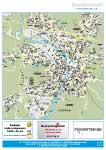Welcome to Eskilstuna!
Many call it logistics in Eskilstuna, instead, we talk about taking the road to the good life. Everything is very central and is easy to find. A straight track to the castle, shopping, golf, culture, etc.. A city in the middle of Mälardalen that gives you time over for other things.
The Park Zoo with newly arrived Hippopotamuses, shopping, horseback riding, boat trips and golf. You realize pretty quick there is much to do during your visit to Eskilstuna..
Municipality Facts
Population
93 101
Area
1 257,53 km²
Regional Center
Eskilstuna
County
Södermanland
More Information
Internet
www.eskilstuna.se www.eskilstuna.nu
Newspapers
Eskilstuna-Kuriren med Strengnäs Tidning www.ekuriren.se Folket www.folket.se
Tourist Bureaus
Eskilstuna Tourist Bureau Stora Fristadshuset, Rademachersmedjorna,Rademachergatan 50, Eskilstuna +46 16-710 70 00
Notes
Emergency
112
Police
114 14
Country Code
+46
Area Code
016
City
About
Welcome to Eskilstuna
Many call it logistics in Eskilstuna, instead, we talk about taking the road to the good life. Everything is very central and is easy to find. A straight track to the castle, shopping, golf, culture, etc.. A city in the middle of Mälardalen that gives you time over for other things. The Park Zoo with newly arrived Hippopotamuses, shopping, horseback riding, boat trips and golf. You realize pretty quick there is much to do during your visit to Eskilstuna..
See and Do
Swimming
Bathing Places
Outdoors: You can find bathing places at the following areas; Sundbyholm, Mälarbaden, Vilsta, Skjulsta, Borsökna, Gillberga-Näs, Hjälmaresund, Stora Sundby och Hållsta grusgrop. www.eskilstuna.se/badplatser
The Park Zoo - Bathing
Heated outside pool. +46 16-10 01 10 www.parkenzoo.se
Vattenpalatset (The Water Palace)
Vattenpalatset (The Water Palace) is an indoor swimming adventure place and swimming pool, along with relaxation. +46 16-10 87 00 www.vattenpalatset.se
Fishing
Fishing
Eskilstunaån (river) in the middle of Eskilstuna, is filled with "ädelfiske", a fishing license is required. The River offers traditional fishing, upstream and downstream fishing is free. Fishing equipment rental available. Fishing licenses and items can be found at OKQ8 Västergatan, Jakthuset (The Hunting Shop) and at Görans Sport Fishing. At The Eskilstuna Tourist Office, you can buy a daily fishing license (not an annual pass). Näshultasjön (lake) is 12 km SE of Eskilstuna. Here you can catch pike-perch and pike. Fishing licenses can be purchased at Svalbovikens Bus. +46 16-830 00 Hjälmaren and Mälaren. Free fishing with a handheld fishing line. Perch, pike-perch and eel can be caught here. Free information can be found at Eskilstuna Tourist Office. +46 16-12 65 08, +46 70-915 85 27 www.eskilstuna.sportfiskarna.se
Lake Hjälmaren and Lake Mälaren
In Lake Hjälmaren and Lake Mälaren, one can fish for free if using a handheld line. Perch, pike-perch and eel can be caught here. Free information can be found at Eskilstuna Tourist Office.
Lake Näshultasjön
Lake Näshultasjön is located 12 km SE Eskilstuna. You can catch pike-perch and pike. Fishing licenses can be purchased at Svalbovikens Bus. +46 16-830 00
Museum
Ebeling Museum
Ebeling Museum opened in 1997, and displays paintings, ceramics and sculptures by Torshälla multifaceted artist profile, Allan Ebeling (1897-1975). The museum also has paintings and graphics of his daughter Marianne Ebeling (1930-1979), and the Photo Bäckstrand library has a large number of images from Torshälla. Ebeling Museum also arranges regular temporary exhibitions. Eskilstunavägen 5, Torshälla +46 16-710 73
Eskilstuna Art Museum
The summer of 2006, Eskilstuna Art Museum moved to Bolinder Munktell, an old Cog workshop, in the city of Munktell. In the old industrial buildings, dating from 1917, is now the art museums collections from the 1600s, up until the present, five rooms for temporary exhibitions, two educational workshops, art library, shop and restaurant. Since the autumn of 2007, Eskilstuna Art Museum also houses the Swedish Children's Picture Archive. Eskilstuna Art Museum is at the new location in the city of Munktell. The façade was designed by the architect Cyrillus Johansson in 1917. The museum shop offers art books, graphic sheets, textiles, ceramics, glass, jewelry, postcards and much more small goods for sale. There is also a restaurant. Art Workshop & The Media Lab offers special activities for school children throughout the Eskilstuna municipality, but even schools outside the municipalities are welcome for a small fee. Portgatan 2, Munktellstaden, Eskilstuna +46 16-710 13 69
Eskilstuna City Museum
Eskilstuna City Museum offers diversified and varied activities with an emphasis on industrial history. The Eskilstuna City Museum also has the "Faktoriet", "Rademachersmedjorna", "Lagersbergs säteri" (manor), "Sörmlandsgården" (Garden) and "Vapentekniska" (technical weapons) collections in Eskilstuna. We also work with the cultural environment, and architectural, documentation, education, and more. There are about 60,000 objects in our collections which reflect Eskilstunas history and also approximately 250,000 photographs from Eskilstuna. Overall, we are 30 employees. Our offices are in "Kanonhuset" (The Canon House) with beautiful location on Faktoriholmarna (islets). Most of us have our office here as well. Faktorigatan 3, Eskilstuna +46 16-710 23 75
Faktoriet (Museum)
Faktoriet is a museum and a meeting place for technology and industrial history. In the building was "Carl Gustafs Stads Gevärsfaktori" until 1969, ten years later the first parts of the museum opened. Today, there are steam engines, the experiment room "Factotum", the city's historical exhibition "Between the Lakes", engaging temporary exhibitions, a workshop with machinery from the turn of the century (1900), a small cafe and a shop with books, games, gifts and handicrafts. "Planket" is a room where associations can display their own exhibitions. Faktoriholmarna i Eskilstuna +46 16-710 23 75
Munktellmuseet (Museum)
Text from Munktellmuseets site: Welcome to experience 175 years of Swedish industrial history! At Munktellmuseet in Eskilstuna, you can see the first Swedish tractor from 1913 and the first wheel loaders from 1954. In addition, you'll find the world's first series of manufactured dump trucks with the Swedish sounding name "GrusKalle." Munktellstorget, Eskilstuna +46 16-15 12 39, +46 16-15 13 75 munktellmuseet.volvo.com
Worth Seeing
Bergströmska gården (Estate Garden)
A the walk from Torshälla Church is Bergströmska estate, from the 1700's. By a miracle, it survived the disastrous fire in 1798 which burned down almost the entire city. Here you can see how estates could have looked a couple of hundred years ago. The estate is named after the last owner, Johan Petter Bergström, a banker and is now refurnished in the old style. Today, the estates has collections by "Torshälla Hembygdsförening", St. Olofs Gille, and in cooperation with Torshälla City management. Next to the estate is Mormorstäppan. Bergströmska estate gardens are privately owned, but are taken care of by St. Olofs Gille. Lilla gatan 12, Torshälla +46 16 - 710 73 23, +46 16 710 73 33
Lagersbergs Manor
Lagersbergs Manor is one of the country's most genuine "karolinergårdar" with a partially retained interior. The manor is located about three kilometers southwest of Eskilstuna center. In addition to the main building there are wings, administration buildings and servants quarters. Lagersbergs Manor has a long history. In the Middle Ages it was called "Hunstad" and was owned by Johanniterklostret in Eskilstuna. During the Reformation, the estate suffered and for a time the soil was worked to pay tax and the state. In the 1660's, the Nobleman Erik Dryselius Lagerqvist took over the manor. In 1668, the property was awarded manor privileges which meant some tax relief awarded the property säteriprivilegier, which meant some tax relief but also demanded that the manor would always stay as a manor. During the 1700's the estate was in succession within the family von Siegroth, a noble family that owned several cargoes in Sörmland. Colonel Conrad Gustaf von Siegroth renamed the manor to Lagersberg and during the mid-1700s it was redone as it looks today. In the main building, there are a number of roof and wall paintings preserved from that era. In the early 1800s, Lagersbergs Manor was owned by the Industrialist Birger Fredrik Rothoff before the last stately owner of the family Persson, and taking over the manor in the 1870s. Sven Persson was agronomist and developed agriculture in Lagersberg. He also had a strong interest in the farm's cultural and historical values, and could be inherited by his children. Since 1991, the manor is owned and managed by the Foundation Lagersberg, which was founded by the family Persson. During the summer, the manors main building and state house is open for visitors. In one of the main wings there is a summer café. Concerts are also arranged during the summer. +46 16-710 23 75
Rådhuset (City Hall)
The city hall was built in 1833 and is a third of the city's history. Before 1971, when municipals merged with Eskilstuna, the house was used for Town Hall meetings and earlier was the local for the Registry Office and Magistrates Court. In the Town Halls attic, there were two Detention Centres, for people who would be tried in magistrates `court in Torshälla. The Detention Centers are now museums. Tornurets unique works are from the 1500s. Medborgarkontoret, Brogatan 13, Torshälla +46 16-710 73 70
Sigurdsristningen (Sigurd stones)
Sigurdsristningen are stones with engraved runic characters near Sundbyholm, from the 1000's. The images reflect the myths about Sigurd Fafnesbane, while the text is about building a bridge over Ramsundet. At the ristningen, you can see Sigurd, on behalf of his foster father Regin, bury his sword in Fafners abdomen to access the snakes treasures. When Sigurd should then roast Fafners heart, he burns himself. He sticks his finger in the mouth and gets snake blood in his mouth, which means that he understands what the birds are saying in the trees. They tell of Regin's deceit and that Sigurd herself should keep the treasure. Sigurd slays Regin by chopping his head off (on the left side of the ristningen is a man without a head). He loads the treasure on Grane's horse (the horse is tied to a tree) and rides away. Sigurdsristningen is the most remarkable and imaginative engraved stones that exists in the world. Sigurdsristningen and the bridge were constructed by Sigrid to honor the memory of her husband Holmger. The Ristningen is in the background of the bridge so no one could escape it when they passed over the 65-meter long bridge. +46 16-710 23 75
Sörmlandsgården - Open Air Museum
Sörmlandsgården is an open-air museum on Djurgården in Eskilstuna. The house shows a typical Swedish farm from the mid-1800s and how it could look. The Buildings and objects are collections of the farmer Erik Andersson in Gultbrunn. In 1921 he donated the entire collection to Eskilstuna city. During the summer there is a comprehensive program for activities at Sörmlandsgården. Sörmlandsgårdens friends, (a group of folklore societies), are responsible for the events. Visitors can be try making hay, shaving sheep, preparing linseed oil, taste newly made butter, dance or listen to lectures. Traditionally, Midsummer is celebrated each year. In the vicinity of Sörmlandsgården lies the historic Inn "Pilkrog" with serving in a historical environment. The Inn also appears in one of the sculptors Johan Tobias Sergel engravings called "Sergel eats dinner at Pilkrog." In the area of Djurgården there is also an ancient castle and several graves from the Iron Age. Djurgården i Eskilstuna +46 16–710 13 70
The Rademacher Forges
For 350 years, Rademachersmedjorna has been used for the manufacturing of knives, scissors, sewing needles, pins, locks, pistols, tools and nails. The first smithy was in 1659 and was part of Carl Gustavs City Mill, constructed and named after King Carl Gustav X. The owner of the mill was Reinhold Rademacher, which the king enticed here from Livland, and in his quest to develop the Swedish forge. The King's architect, Jean de la Vallée, designed a plan for the Carl Gustav City with 120 forges built of stone. It resulted in 20 forges made of wood and belonged as part of the residential building and shed. The vicinity was for farming and grazing the animals. Some of the original smithy houses are still left on Rademacherområdet. In each smithy house was the master himself and his family and also the journeyman and apprentices. This meant that it could be rather crowded in the home. In 1906, Eskilstunas opened the first museum in one of the smithy's. In the meantime, the region developed into a culture reserve and the crafts and traditions were kept alive and in the small, red houses, it is still full activity. Today, there is cutlery, copper, ceramic artist, goldsmith, art gallery, handicraft butique and "Jernberghska" Restaurant-Cafe-Banquet Hall and more. In the large "Fristadshuset" are Eskilstuna Tourist Bureau and Eskilstuna Marketing AB. During the spring and autumn the Arts and Craft Days are arranged and at the first advent of each year is the traditional Christmas market in the smithy. Rademachersmedjornas is also used for outside theater, concerts and singing. Rademachergatan 48-50, Eskilstuna +46 16-710 23 75
Med reservation för eventuella ändringar






 বাংলা
বাংলা Dansk
Dansk Deutsch
Deutsch Suomi
Suomi Français
Français Ελληνικά
Ελληνικά Íslenska
Íslenska Nederlands
Nederlands Norsk
Norsk Português
Português Svenska
Svenska 简体中文
简体中文 繁體中文
繁體中文 Español
Español Italiano
Italiano 日本語
日本語 한국어
한국어 Polski
Polski Русский
Русский Türkçe
Türkçe
